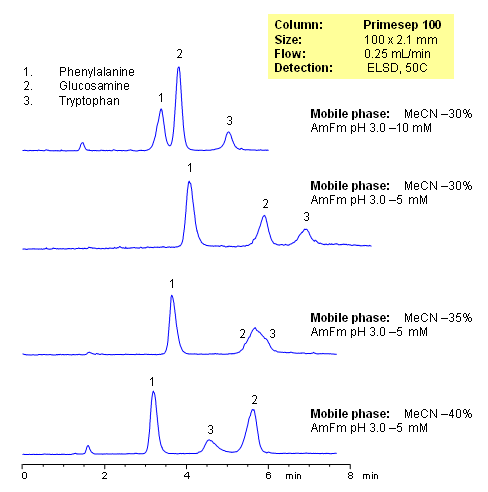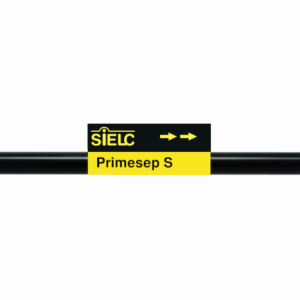| CAS Number | 3416-24-8 |
|---|---|
| Molecular Formula | C6H13NO5 |
| Molecular Weight | 179.172 |
| InChI Key | MSWZFWKMSRAUBD-QZABAPFNSA-N |
| LogP | -2.34 |
| Synonyms |
|
Applications:
ELSD-HPLC Method for Analysis of Glucosamine (Hydrochloride) on Primesep S Column
December 6, 2024
HPLC Method for Analysis of Glucosamine on Primesep S by SIELC Technologies

High Performance Liquid Chromatography (HPLC) Method for Analysis of Glucosamine
Glucosamine is a naturally occurring compound primarily found in cartilage, which cushions and supports joints. It is widely used as a dietary supplement to promote joint health and alleviate symptoms of osteoarthritis, such as stiffness and pain. Commonly sourced from shellfish or produced synthetically, glucosamine is available in forms like glucosamine sulfate, glucosamine hydrochloride, and N-acetyl glucosamine. It supports the repair and maintenance of cartilage and connective tissues, playing a vital role in joint flexibility and mobility.
Glucosamine can be retained and analyzed using an Primesep S mixed-mode stationary phase column. The analysis employs an isocratic method with a simple mobile phase consisting of water, acetonitrile (MeCN), and ammonium formate as a buffer. Detection is achieved using ELSD.
| Column | Primesep S, 4.6 x 100 mm, 5 µm, 100 A, dual ended |
| Mobile Phase | MeCN/H2O – 50/50% |
| Buffer | Ammonium formate pH 3.0 – 40 mM |
| Flow Rate | 1.0 ml/min |
| Detection | ELSD, the nebulizer and evaporator temperatures 40°C, with a gas flow rate of 1.6 Standard Liters per Minute (SLM) |
| Sample | 6.7 mg/ml |
| Injection volume | 2 µl |
| LOD* | 149 ppb |
| Class of Compounds | Quaternity amines |
| Analyzing Compounds | Glucosamine |
Application Column
Primesep S
Column Diameter: 4.6 mm
Column Length: 100 mm
Particle Size: 5 µm
Pore Size: 100 A
Column options: dual ended

HPLC Retention of Glucosamine
August 22, 2008

Glucosamine is an amino sugar that is used as precursor in synthesis of glycosylated proteins and peptides. Glucosamine is also a component of several medications, example being oral glucosamine being is used to treat arthritis. It is a very polar compound with no UV activity and pKa of 11. Compound is not retained on modern HPLC columns without ion-pairing reagents. It is often required to quantitate glucosamine in complex matrices with LC/MS detection, making the use of ion-pairing reagents impossible. In this HPLC application glucosamine is retained by cation-exchange mechanism on Primesep 100 mixed-mode column. Retention of glucosamine is controlled by buffer nature, buffer concentration and buffer pH. Method can be used for fast determination of glucosamine in mixtures with proteins, sugars and sugar phosphates. ELSD and LC/MS are detection of choice for polar non-UV active compounds.
Application Column
Primesep 100
The Primesep family of mixed-mode columns offers a wide variety of stationary phases, boasting unprecedented selectivity in the separation of a broad array of chemical compounds across multiple applications. Corresponding Primesep guard columns, available with all stationary phases, do not require holders. SIELC provides a method development service available to all customers. Inquire about our specially-tailored custom LC-phases for specific separations.
Select options
HPLC Separation of Phenylalanine, Glucosamine, and Tryptophan on Mixed-Mode Column
October 4, 2007

The Separation of Phenylalanine, Glucosamine and Tryptophan demonstrates how the small changes to the organic and/or buffer concentrations in the mobile phase affect the retention of compounds on a mixed-mode column by hydrophobic, ion-exchange and ion-exclusion mechanisms in reverse-phase HPLC chromatography. Evaporative Light Scattering Detector (ELSD) used
| Column | Primesep 100, 2.1×100 mm, 5 µm, 100A |
| Mobile Phase | MeCN/H2O |
| Buffer | AmFm |
| Flow Rate | 0.25 ml/min |
| Detection | ELSD |
| Class of Compounds |
Drug, Acid, Hydrophilic, Ionizable, Vitamin, Supplements, Amino acid |
| Analyzing Compounds | Phenylalanine, Glucosamine, Tryptophan |
Application Column
Primesep 100
The Primesep family of mixed-mode columns offers a wide variety of stationary phases, boasting unprecedented selectivity in the separation of a broad array of chemical compounds across multiple applications. Corresponding Primesep guard columns, available with all stationary phases, do not require holders. SIELC provides a method development service available to all customers. Inquire about our specially-tailored custom LC-phases for specific separations.
Select optionsPhenylalanine
Tryptophan

HPLC Separation of Glucosamine from Chondroitin Sulfate
March 27, 2006

Glucosamine is an amino sugar believed to play a role in cartilage formation and repair. Chondroitin sultate gives cartilage elasticity. Primesep 500 separates glucosamine and chondroitin sulfate with baseline resolution. Chondroitin sulfate is separated from chloride ion by ion exclusion and glucosamine is separated by sodium ion by ion exchange and reversed phase. The HPLC separation uses a mobile phase of water, acetonitrile (MeCN, ACN), and ammonium formate with evaporative light scattering detection (ELSD) 90C.
Application Column
Primesep 500
The Primesep family of mixed-mode columns offers a wide variety of stationary phases, boasting unprecedented selectivity in the separation of a broad array of chemical compounds across multiple applications. Corresponding Primesep guard columns, available with all stationary phases, do not require holders. SIELC provides a method development service available to all customers. Inquire about our specially-tailored custom LC-phases for specific separations.
Select optionsGlucosamine





